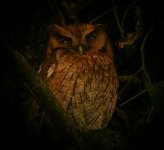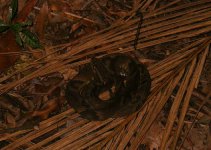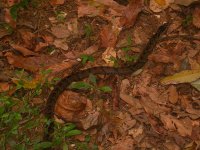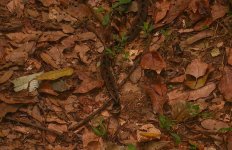
I had quite an entertaining weekend, although some of this entertainment involved spending hours being bitten by mosquitos whilst trying and failing to see birds. It's an interesting experience in some ways, but as John Peel once said, being beaten up's interesting.
The first forlorn quest was to try to see Uniform Crake. I'd previously been informed that this was the hardest bird to see in South America, but was given some inspiration, and a few tips, by Scott Olmstead who actually managed to see one here on Wednesday morning (when I was busy catching up on notes). I followed the instructions to the letter, but the crakes didn't seem too impressed. The battle will be rejoined at a later stage. I saw a huge, almost caiman sized iguana while I was waiting though.
On Saturday I had a good dusk walk around the wetlands, when I recorded one of Regua's many Pauraques. I often wonder if there are numerous folk songs in Latin America that cite Pauraques in much the same way and with the same frequency as North American folk songs cite Whippoorwills. It's that kind of sound. I also managed some good flight views of a Giant Snipe, which gave a quick whistle as it sailed off down the valley.
On Sunday I went for a walk up the Waterfall Trail, and ended up spending all day there. The highlight was having good views of Slaty Bristlefront in the bamboo. It wasn't singing too much, and I only managed to record one quick burst of song. Compare and contrast with the recording of Stresemann's Bristlefront from earlier in the thread. Other good birds along the trail were Black-throated Trogon, Olive-green Tanager and a small group of Red-legged Honeycreepers. A real highlight was seeing Blue Manakins display. A real 'Attenborough moment'. I think this cropped up on 'The Life of Birds' but seeing it going on in front of you is something else. There was a bit at the end where all the males sort of bowed down, perhaps hoping for a positive response from the female. Sad to say, it wasn't forthcoming. I think they are a little crazy though.
I also managed to spend three hours trying to see a bird I could hear singing. And I didn't see it. I got lots of recordings though! It turned out to be a Spot-backed Antshrike. I was thinking it sounded like an antthrush though, and so I kept looking on the ground for it. Plus, the song is very hard to locate, even when it's quite close. That's my excuse anyway. I will return, battle-scarred but wiser.
Some sounds for you:
1. The only response I had from Uniform Crake.
2. A bit of Pauraque chorus or what Brazilians like to sing about when their woman gone left them. Possibly.
3. A nice bit of prime Bristlefront. I like a bit of Bristlefront.
4. Those crazy guys, the Blue Manakins. Whatever will they think of next.
The first forlorn quest was to try to see Uniform Crake. I'd previously been informed that this was the hardest bird to see in South America, but was given some inspiration, and a few tips, by Scott Olmstead who actually managed to see one here on Wednesday morning (when I was busy catching up on notes). I followed the instructions to the letter, but the crakes didn't seem too impressed. The battle will be rejoined at a later stage. I saw a huge, almost caiman sized iguana while I was waiting though.
On Saturday I had a good dusk walk around the wetlands, when I recorded one of Regua's many Pauraques. I often wonder if there are numerous folk songs in Latin America that cite Pauraques in much the same way and with the same frequency as North American folk songs cite Whippoorwills. It's that kind of sound. I also managed some good flight views of a Giant Snipe, which gave a quick whistle as it sailed off down the valley.
On Sunday I went for a walk up the Waterfall Trail, and ended up spending all day there. The highlight was having good views of Slaty Bristlefront in the bamboo. It wasn't singing too much, and I only managed to record one quick burst of song. Compare and contrast with the recording of Stresemann's Bristlefront from earlier in the thread. Other good birds along the trail were Black-throated Trogon, Olive-green Tanager and a small group of Red-legged Honeycreepers. A real highlight was seeing Blue Manakins display. A real 'Attenborough moment'. I think this cropped up on 'The Life of Birds' but seeing it going on in front of you is something else. There was a bit at the end where all the males sort of bowed down, perhaps hoping for a positive response from the female. Sad to say, it wasn't forthcoming. I think they are a little crazy though.
I also managed to spend three hours trying to see a bird I could hear singing. And I didn't see it. I got lots of recordings though! It turned out to be a Spot-backed Antshrike. I was thinking it sounded like an antthrush though, and so I kept looking on the ground for it. Plus, the song is very hard to locate, even when it's quite close. That's my excuse anyway. I will return, battle-scarred but wiser.
Some sounds for you:
1. The only response I had from Uniform Crake.
2. A bit of Pauraque chorus or what Brazilians like to sing about when their woman gone left them. Possibly.
3. A nice bit of prime Bristlefront. I like a bit of Bristlefront.
4. Those crazy guys, the Blue Manakins. Whatever will they think of next.
Attachments
Last edited:







